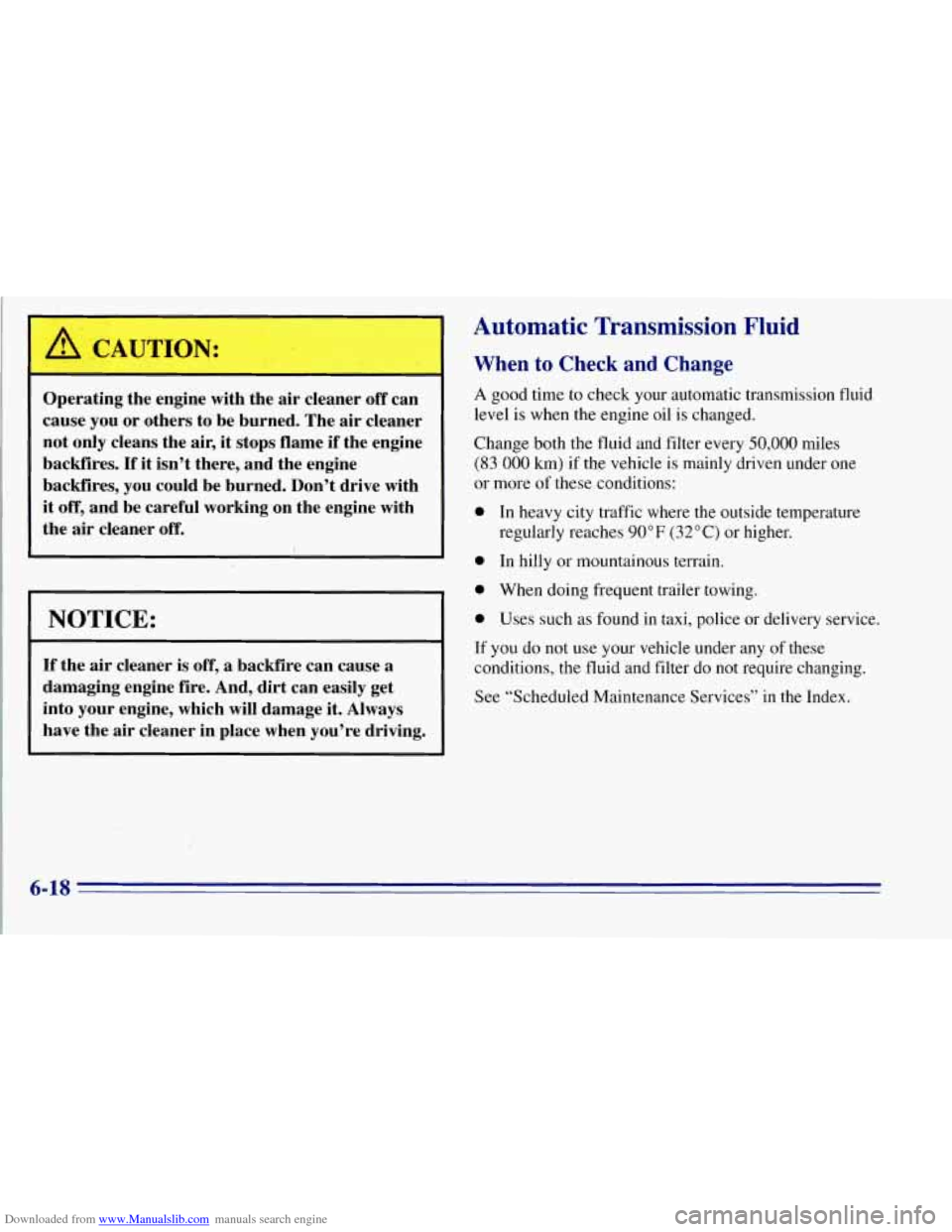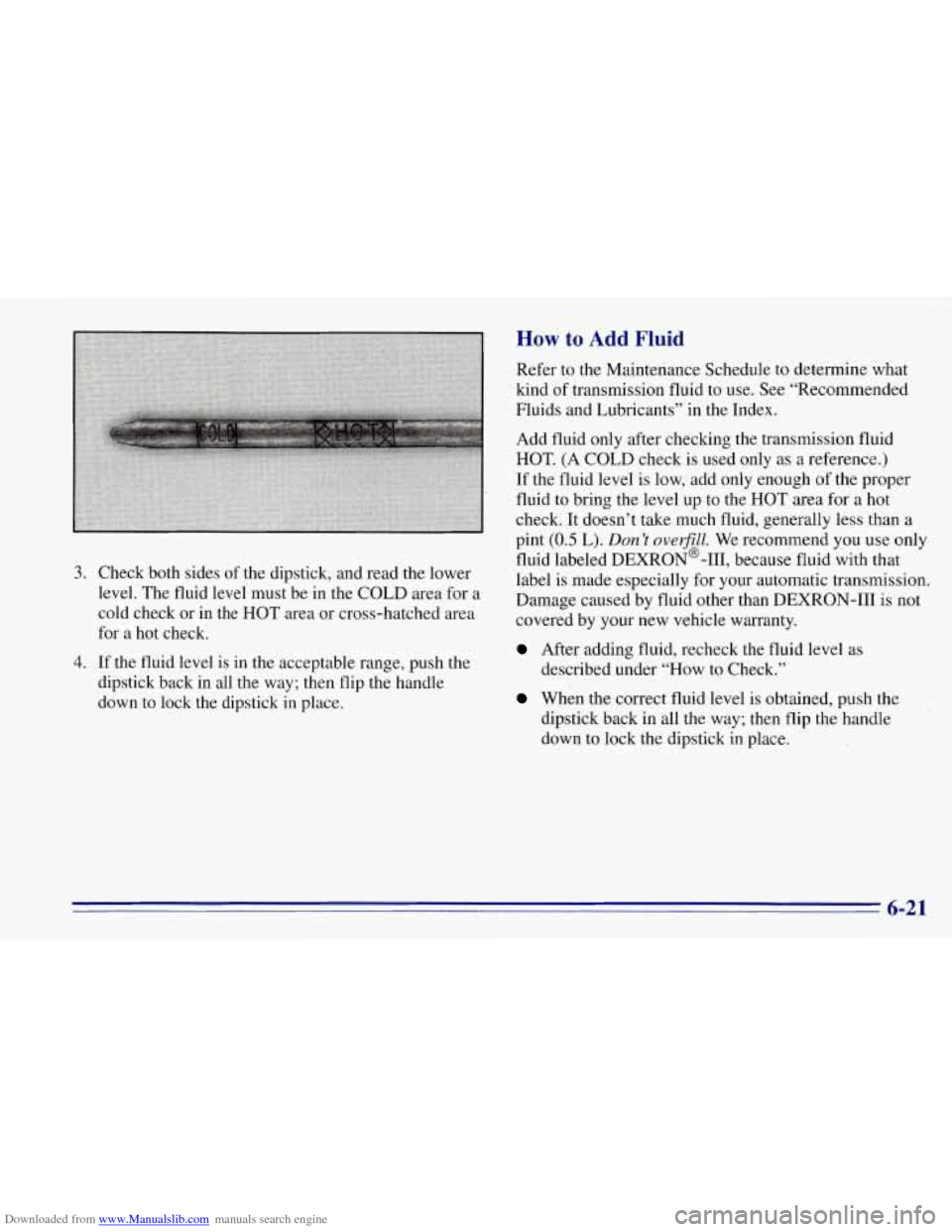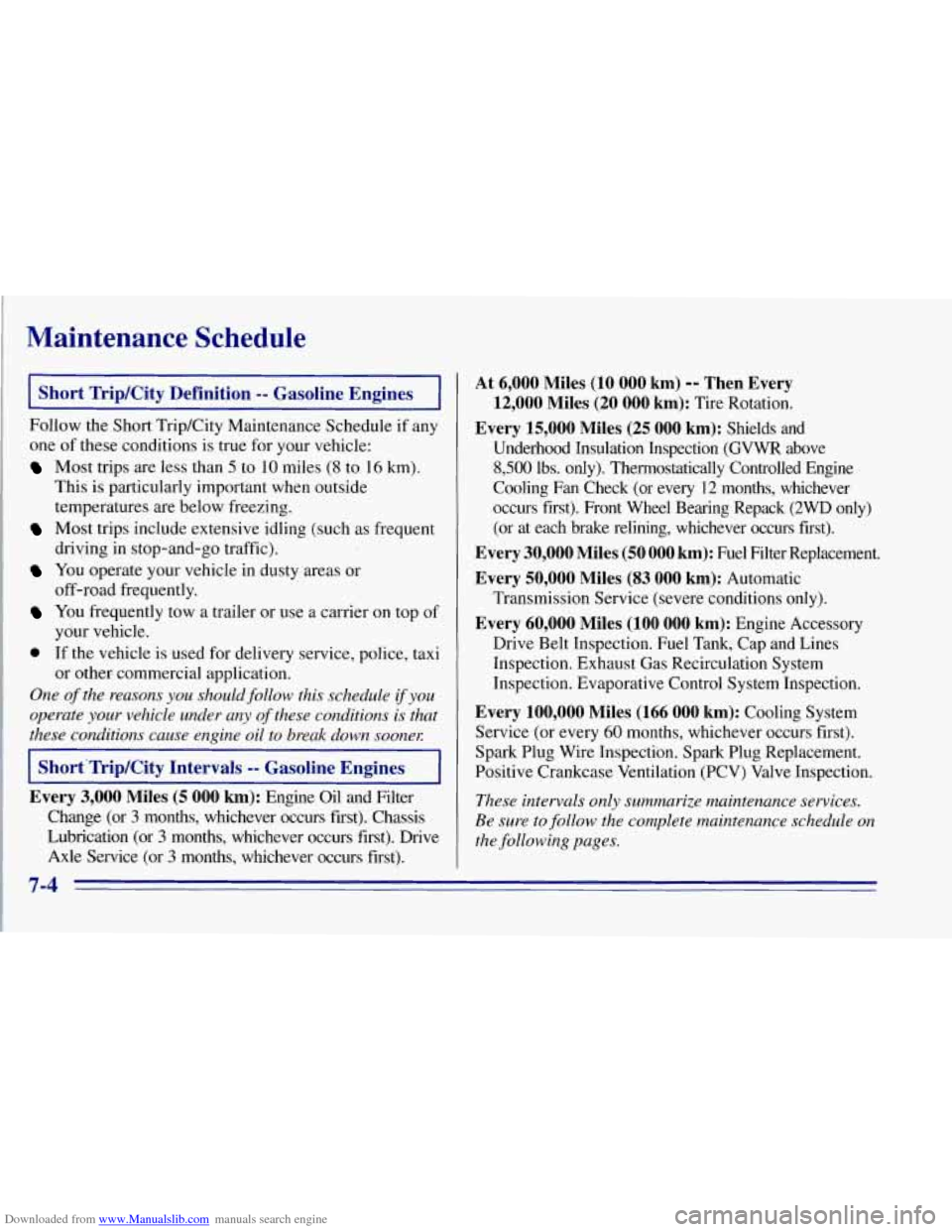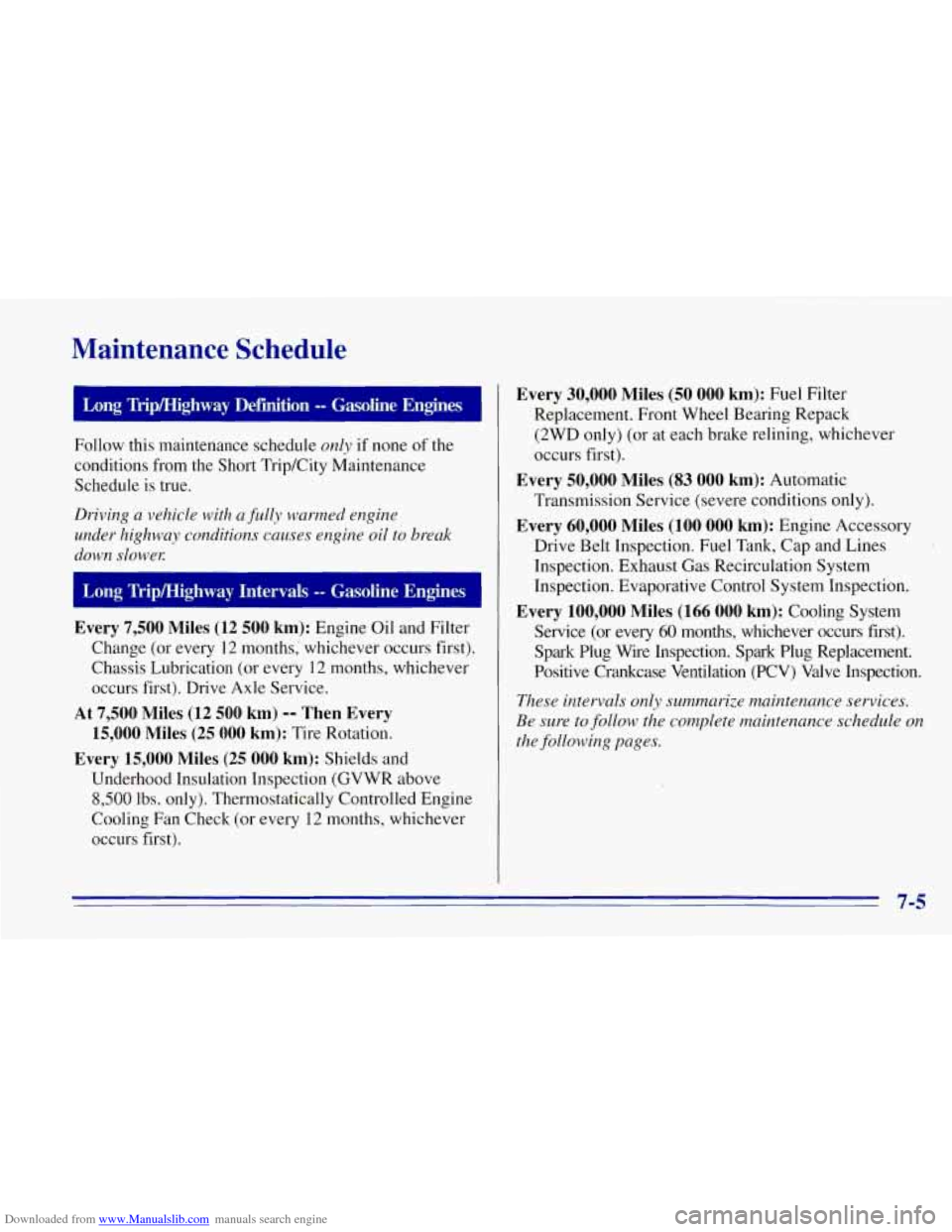Page 225 of 403

Downloaded from www.Manualslib.com manuals search engine If No Steam Is Coming From Your Engine
If you get the overheat warning but see or hear no
steam, the problem may not be too serious. Sometimes
the engine can get a €ittle too hot when you:
Climb a long hill on a hot day.
Stop after high-’speed driving.
Idle for long periods in traffic.
Tow a trailer. See “Driving on Grades” in the Index.
If you get the overheat warning with no sign of steam,
try this for a minute or
so:
1. If you have an air conditioner, turn it off.
2. Turn on your heater to full hot at the highest fan
speed and open the window as necessary.
3. If you’re in a traffic jam, shift to NEUTRAL (N);
otherwise, shift to the highest gear while
driving
-- AUTOMATIC OVERDRIVE (a) or
DRIVE
(3) for automatic transmissions. If
you no
longer have the overheat warning, you
can drive. Just to be safe, drive slower for about
10 minutes. If the warning doesn’t come back on,
you can drive normally.
If the warning continues, pull over, stop, and park your
vehicle right away.
If there’s still
no sign of steam, push the accelerator until
the engine speed is about twice as fast as normal idle
speed. Bring the engine speed back to normal idle speed
after two or three minutes. Now
see if the warning stops.
But then, if you still have the warning,
turn offthe
engine
and get everyone out of the vehicle until it
cools down.
You may decide not to lift the hood but to get service
help right away.
5-10
Page 262 of 403
Downloaded from www.Manualslib.com manuals search engine A. Battery
B. Air Cleaner
C. Radiator Cap
D. Coolant Recovery Tank
E. Air Filter Restriction Indicator
F. Engine Oil Dipstick
G. Automatic Transmission Dipstick
H. Fan
I. Power Steering Fluid Reservoir
J. Engine Oil Fill
. I '.. t .. L $K. , .,J Brake Fluid Reservoir
L. Windshield Washer Fluid Reservoir
M. Fusemelay Center
N. Storage Compartment
6-9
Page 264 of 403
Downloaded from www.Manualslib.com manuals search engine A. Battery
8. Coolant Recovery’Tank
C. Air Cleaner
D. Radiator Cap
E. Air Filter Restriction Indicator
E Engine Oil Dipstick
G. .Automatic Transmission Dipstick
H. Engine Oil Fill
I. Fan
J. Power Steering Fluid Reservoir
K. Brake Fluid Reservoir
L. Storage Compartment
M. Windshield Washer Fluid Reservoir
N. Fuse/Relay Center
.. 6-11
Page 271 of 403

Downloaded from www.Manualslib.com manuals search engine A ,CAUTION:
Operating the engine with the air cleaner off can
cause
you or others to be burned. The air cleaner
not only cleans the air, it stops flame
if the engine
backfires.
If it isn’t there, and the engine
backfires, you could be burned. Don’t drive with
it
off, and be careful working on the engine with
the air cleaner off.
I
NOTICE:
If the air cleaner is off, a backfire can cause a
damaging engine fire. And, dirt can easily get
into your engine, which will damage
it. Always
have the air cleaner in place when you’re driving.
Automatic Transmission Fluid
When to Check and Change
A good time to check your automatic transmission fluid
level
is when the engine oil is changed.
Change both the fluid and filter every
50,000 miles
(83 000 Ism) if the vehicle is mainly driven under one
or,more of these conditions:
0 In heavy city traffic where the outside temperature
regularly reaches
90” F (32 O C) or higher.
0 In hilly or mountainous terrain.
0 When doing frequent trailer towing.
0 Uses such as found in taxi, police or delivery service.
If you do not use your vehicle under any of these
conditions, the fluid and filter do not require changing.
See “Scheduled Maintenance Services” in
the Index.
6-18
Page 274 of 403

Downloaded from www.Manualslib.com manuals search engine How to Add Fluid
Refer to the Maintenance Schedule to determine what
kind
of transmission fluid to use. See “Recommended
Fluids and Lubricants” in the Index.
Add fluid only after checking the transmission fluid
HOT. (A COLD check is used only as a reference.)
.If the fluid level is low, add only enough of the proper
fluid to bring the level up to
the HOT area for a hot
check. It doesn’t take
much fluid, generally less than a
pint
(0.5 L). Don ’t ovetjill. We recommend you use only
fluid labeled DEXR0N’-III, because fluid with that
3. Check both sides of the dipstick, and read-the lower label is made especially for your automatic transmission.
level. The fluid level IINLSt be in the COLD area for a Damage cauwd by fluid other than DEXRO;N-III
is not
cold check or in the HOT area or cross-hatched area covered b\
y
your new vehicle warranty.
for a hot check.
After adding fluid, recheck the fluid level as 4. If the fluid level is in the acceptable range, push the
dipstick back in all the way; then flip the handle
down to lock the dipstick in place.
whin the correct fluid level is obtained, push the
described under “How to Check.”
dipstick back in all the way; then flip the handle
down to lock the dipstick in place.
’
6-21
Page 318 of 403
Downloaded from www.Manualslib.com manuals search engine Fuse Usage
13 ........ Power Amp, Rear Liftglass, Cigarette
Lighter, Door Lock Relay, Power
Lumbar Seat
Comfort Controls, instrument
Switches, Radio Illumination,
Chime Module
15
........ DRL Relay, Fog Lamp Relay
16
........ Front and Rear Turn Signals, Back-up
Lamps, BTSI Solenoid
17
........ Radio (Ignition)
18
........ 4WAL/VCM, ABS, Cruise Control
19
........ Radio (Battery)
14
........ 4WD Indicator, Cluster,
Front and Rear
Fuse Usage
20 ........ PRNDL, Automatic Transmission,
4. ,,/ J - ;c- ; Speedometer, Check Gages, .. '.. - *. 1'). 'I :,,:-: . .-.?Warning ,. Lights .- .
21 ........ Not Used
22
........ Not Used
23
........ Rear Wiper, Rear Washer Pump
24
........ Front Axle, 4WD Indicator Lamp, TP2
Relay (Gasoline Engine)
A ......... Power Door Lock, Six-Way Power
Seat, Keyless Entry Module
B ......... Power Windows
6-65
Page 331 of 403

Downloaded from www.Manualslib.com manuals search engine Maintenance Schedule
Short Trip/City Definition -- Gasoline Engines
Follow the Short TripKity Maintenance Schedule if any
one of these conditions is true
for your vehicle:
Most trips are less than 5 to 10 miles (8 to 16 km).
This is particularly important when outside
temperatures are below freezing.
driying in stop-and-go traffic).
off-road frequently.
your vehicle.
or other, commercial application.
Most trips include extensive idling (such as frequent
You operate your vehicle in dusty areas or
You frequently tow a trailer or use a carrier on top of
0 If the vehicle is used for delivery service, police, taxi
One of the reasons you should follow this schedule if you
operate your vehicle under any
of these conditions is that
these conditions cause engine oil to break down soonel:
Short'Trip/City Intervals -- Gasoline Engines
Every
3,000 Miles (5 000 km): Engine Oil and Filter
Change (or
3 months, whichever occurs first). Chassis
Lubrication (or
3 months, whichever occurs first). Drive
Axle Service (or
3 months, whichever occurs first).
At 6,000 Miles (10 000 km) -- Then Every
12,000 Miles (20 000 km): Tire Rotation.
Every 15,000 Miles (25 000 km): Shields and
Underhood Insulation Inspection (GVWR above
8,500 lbs. only). Thermostatically Controlled Engine
Cooling
Fan Check' (or every 12 months, whichever
occurs first). Front Wheel Bearing Repack
(2WD only)
(or at each brake relining, whichever occurs first).
Every 30,000 Miles (50 000 km): Fuel Filter Replacement.
Every 50,000 Miles (83 000 km): Automatic
Transmission Service (severe conditions only).
Every 60,000 Miles (100 000 km): Engine Accessory
Drive Belt Inspection. Fuel Tank, Cap and Lines
Inspection. Exhaust Gas Recirculation System
Inspection. Evaporative Control System Inspection.
Every 100,000 Miles (166 000 km): Cooling System
Service (or every
60 months, whichever occurs first).
Spark Plug Wire Inspection. Spark Plug Replacement.
Positive Crankcase Ventilation (PCV) Valve Inspection.
These intervals only summarize maintenance services.
Be sure to follow the complete maintenance schedule
on
the following pages.
Page 332 of 403

Downloaded from www.Manualslib.com manuals search engine Maintenance Schedule
Follow this maintenance schedule only if none of the
conditions from the Short Trip/City Maintenance
Schedule is true.
Driving a vehicle with a fully warmed engine
under highway conditions causes engine oil to break
down
s10w.e~
Every 7,500 Miles (12 500 km): Engine Oil and Filter
Change (or every
12 months,' whichever occurs first).
Chassis Lubrication (or every 12 months, whicheve
occurs first). Drive Axle Service.
At 7,500 Miles (12 500 km) -- Then Every
15,000 Miles (25
000 km): Tire Rotation.
Every 15,000 Miles (25 000 km): Shields and
Underhood Insulation Inspection (GVWR above :r
8,500 lbs. only). Thermostatically Controlled
Engine
Cooling Fan Check (or every 12 months, whichever
occurs first).
Every 30,000 Miles (50 000 km): Fuel Filter
Replacement. Front Wheel Bearing Repack (2WD only) (or at each brake relining, whichever
occurs first).
Every 50,000 Miles (83 000 km): Automatic
Transmission Service (severe conditions only).
Every 60,000 Miles (100 000 km): Engine Accessory
Drive Belt Inspection. Fuel Tank, Cap and Lines
Inspection. Exhaust Gas Recirculation System
Inspection. Evaporative Control ,System Inspection.
Every 100,000 Miles (166 000 km): Cooling System
Service
(or every 60 months, whichever occurs first).
Spark Plug Wire Inspection.
Spark Plug Replacement.
Positive Crankcase Ventilation (PCV) Valve Inspection.
These intervals only summarize maintenance services.
Be sure to
follow the complete maintenance schedule on
the following pages.
7-5